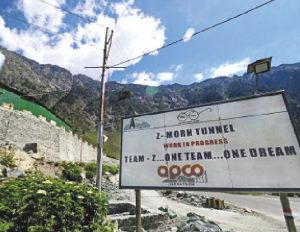 Alarmed by Chinese incursions along the Line of Actual Control in Ladakh, India is speeding up the construction of the 6.5 km Z-Morh tunnel to ensure a round-the-year connectivity between Kashmir valley and Ladakh region. The deadline for the completion of the all-important strategic project has been advanced to June 2021.
Alarmed by Chinese incursions along the Line of Actual Control in Ladakh, India is speeding up the construction of the 6.5 km Z-Morh tunnel to ensure a round-the-year connectivity between Kashmir valley and Ladakh region. The deadline for the completion of the all-important strategic project has been advanced to June 2021.
The information about the status of works on the tunnel was shared at a meeting held on July 22 of National Highway Infrastructure Development Corporation Limited (NHIDCL) chaired by Jammu and Kashmir Chief Secretary BVR Subrahmanyam. The government is also simultaneously working to complete the 13 kilometre Zojila tunnel.
Z-Morh tunnel project comprises 6.5-km tunnel, a 6-km approach road, two major bridges and one minor bridge. The project is worth 2,379 crores. The project includes a 14.15-km tunnel, an 18-km approach road between Z-Morh and Zoji-La tunnel as a single integrated package, besides carriageway, two snow galleries, four major bridges and 18 avalanche-protection dams.
The entire project that will cost 4,430 crores is expected to be operational by June, 2026. Though the work on the Z-Morh had been ongoing for several years, it came to a sudden stop in September 2018 after the non-banking finance company IL&FS that financed it went bust. The IL&FS had won the strategic project along with Srinagar Sonamarg tunnel way through lowest bidding.
However, in January NHIDCL awarded the Z-Morh Tunnel to APCO Amarnathji Tunnelway Pvt Ltd to be built at a cost of 2,379 crore, The pact between NHIDCL and APCO Amarnathji Tunnelway was signed in presence of Road Transport and Highways Minister Nitin Gadkari. At the time, the project was decided to be completed in 3.5 years. But now following the LAC stand-off with the China, the deadline of the completion of the project is June 2021.
An all-weather road has become critical for India’s access to Ladakh in the wake of new developments along the LAC. It will also be a response to the changing geo-strategic landscape of the region, with the situation likely to get worse with China out to flex its muscle on the regional and global stage.
Interestingly, the foundation stone of the Z-Morh tunnel was laid by the Congress leader Rahul Gandhi on October 4, 2012.
In the absence of a tunnel, the road to Ladakh remains buried under 10 feet of snow in winter, disconnecting the region from the rest of the country for six months.
The tunnels are of profound strategic and economic significance. They will eventually bring Jammu and Kashmir and Ladakh union territories together. The projects will have huge economic spin-offs for the people of the two regions. And more importantly it will help rapid mobilization of troops and armour to a strategically critical region bordered by China and Pakistan.
Over the past some years, Ladakh has been subject to the intermittent Chinese intrusions, a sign of Beijing’s growing aggressive regional designs that have come to a ahead with People’s Liberation Army crossing into Indian side of the disputed border at five points — Galwan Valley, Pangon Tso, Hot Springs, Depsang and Gogra. Besides, Ladakh has already been witness to a short war between India and Pakistan over strategic Kargil heights in 1999.
Strategic observers also attribute China’s increasing assertiveness along the LAC to the vast military infrastructure it has built over the years on its side of the LAC. This is said to have given it a strategic reach into India’s peripheries and interiors. But India’s lack of access to its borderlands in Ladakh has been a problem. And it is this problem that is sought to be addressed by launching a slew of ambitious infrastructure projects along the LAC and at strategic points in J&K.
letters@tehelka.com













